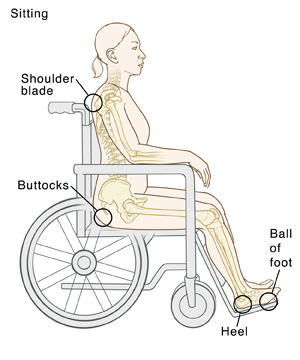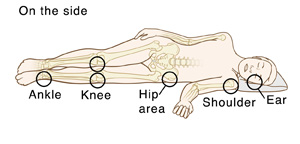What Are Pressure Injuries?
What Are Pressure Injuries?
Pressure injuries (pressure ulcers, pressure sores, or bedsores) happen when pressure on your skin cuts off your blood supply. This usually happens in areas where your bones are closer to the surface (bony prominences). This makes your skin and the tissue below your skin break down. Pressure injuries often happen if you lie or sit in one position for too long. They can be painful and heal slowly. But you can do many things to help stop pressure injuries.
|
Who’s at risk
Anyone who can’t move around on their own is at risk for pressure injuries. The biggest risk factors are:
Staying in a bed or wheelchair
Not being able to change positions without help from someone else
Other risk factors include:
Skin irritation from loss of bladder or bowel control
Poor nutrition
Vascular disease
Smoking
Diabetes
Your role
Your role is to prevent pressure injuries from forming. That means you need to:
Change positions often.
Support your body by using cushions or pillows.
Don't rub or slide.
Keep your skin clean and dry.
Eat a healthy diet and get enough movement.
Check your skin twice a day for signs of skin breakdown.
Where pressure injuries occur
Pressure injuries form where bone presses your skin against a bed or chair. This is most likely to happen in places where there is less padding between the skin and the bone. This includes your head and feet, and around joints like your shoulder, hip, and knee.
When to call your healthcare provider
Call your healthcare provider when you first see any of the following:
Redness that doesn’t go away after the pressure source is removed
Cracked, blistered, or broken skin
Red, shiny skin that is painful or warm to the touch, or that feels spongy or hard
Skin that has lost feeling (sensation)
Updated:
September 06, 2018
Sources:
Zack, AM, 5-Minute Clinical Consult, 2016, 24th ed.
Reviewed By:
Image reviewed by StayWell medical illustration team.,Sudheendra, Deepak, MD,Taylor, Wanda, L., RN, PhD


